“We are looking at a more significant change to the streets.”
– Bryan Poole, PBOT
A plan to update 122nd Ave in east Portland has taken a big step forward. After almost a year of collecting feedback, the Portland Bureau of Transportation has released the 122nd Ave draft project plan. It includes our first look at concepts for a roundabout and other significant changes that could finally tame this street.
122nd Ave is one of the most dangerous corridors in Portland for people walking, biking or taking transit. PBOT readily admits there are major safety concerns on the street: in the draft plan, they state “the wide roadway has inadequate infrastructure and its large intersections are among the most dangerous in the city. Significant changes are needed to save lives and reduce life-altering injuries.”
Right now, 122nd is on PBOT’s High Crash Network, and is generally unpleasant to walk or bike on. PBOT’s goal is that 122nd Ave would not only be a safe place for people walking and biking, but also that it would become a “civic corridor,” which the city defines as a street that is “attractive and safe for pedestrians while continuing to play a major role in the City’s transportation system.”
PBOT identified four recommendation categories in the plan:
● Safety, which will involve “redesigning 122nd to achieve safe driving speeds, safe intersections and better separation between users” and include projects such as implementing more street lighting and pedestrian and bike crossing and improve speed management
● Multimodal and Access Enhancements to “improve the areas where people walk, roll, bike and wait for transit” with projects like protected bike lanes, access management and increased Biketown stations
● Transit Performance and Experience to “ensure buses operate on time even during congested periods” with bus stop and access improvements and transit priority treatments to allow buses to move through car traffic
● Develop 122nd Avenue as a Civic Corridor to “exemplify the benefits of green infrastructure and minimize urban heat island effects, while also being enjoyable places to live, work, and gather” by widening sidewalks, increasing tree canopy coverage and studying the potential for a bus rapid transit service on 122nd Ave
As we reported back in March, tree canopy coverage was a particularly important issue to survey respondents. Shade from trees is essential in pavement-heavy areas like the 122nd Avenue corridor. During last year’s heat wave, some parts of east Portland recorded temperatures of up to 124°F.
For the sake of this plan, PBOT has split the long corridor into three parts. Within the northernmost segment, which stretches from Marine Drive to San Rafael Street, PBOT has unveiled plans to make major changes near the Sandy Boulevard (Hwy 30) intersection.
Currently, there are two free-flowing slip lanes from 122nd south of Sandy that provide access to NE 121st. PBOT suggests closing off those lanes to create T-intersections. The concept shown in the draft plan also calls for new sidewalks and marked crossings.
Below is the current view of this intersection and PBOT’s conceptual design:
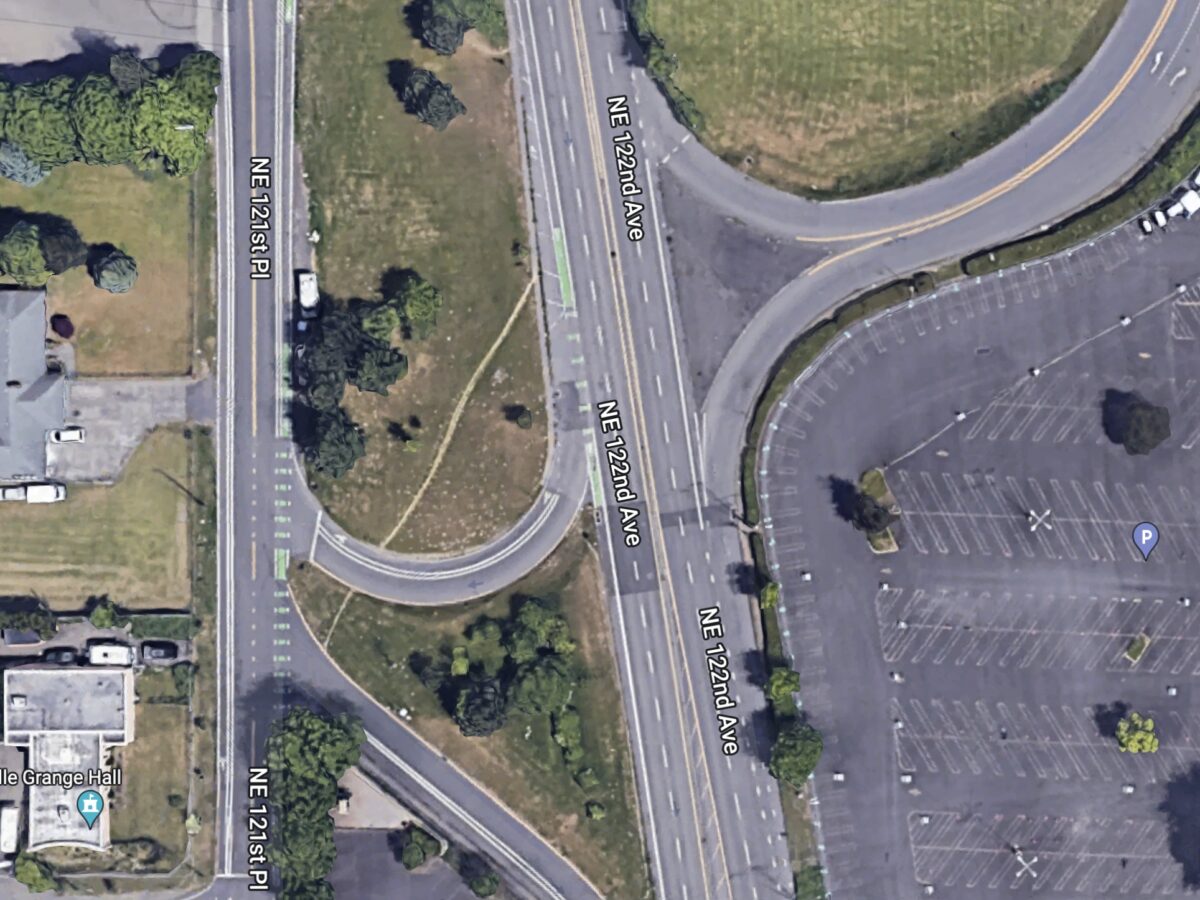

Another notable recommendation is in the southern segment of 122nd, where PBOT wants to reduce the space available to drivers.
We outlined PBOT’s potential design options for this southern stretch in a recent article, but the draft plan brings something new to the table: a roundabout at the intersection of 122nd and SE Harold made possible by a reduction in driving lanes.
“We are looking at a more significant change to the streets,” PBOT planner Bryan Poole said in a June 14 Bicycle Advisory Committee presentation. “Because the volumes are lower, we’re proposing doing a road diet here: reducing the number of vehicle lanes from five to three, providing space to really improve bike facilities and also adding trees along the corridor, which is something we heard a lot about.”
Here’s how it would look compared to current conditions:
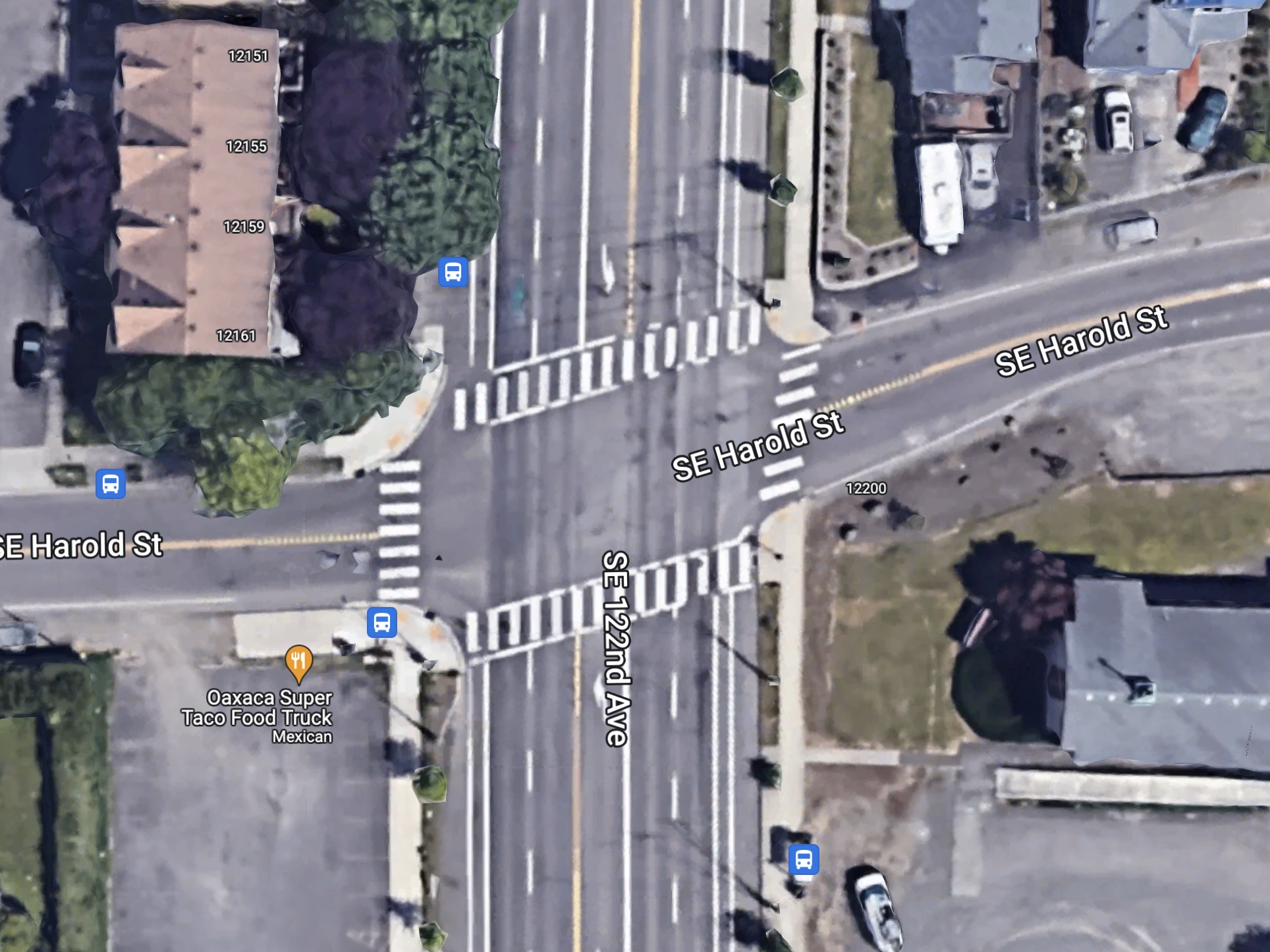

PBOT’s design drawing shows how drivers would face a much more narrow roadway than they do now, which would dramatically reduce speeds and improve safety for everyone. Median islands and extended corners would slow drivers down as they enter the roundabout. The bike lanes are shown as being raised to sidewalk level and would cross adjacent to pedestrian crossings.
Roundabouts on major streets are extremely rare in Portland. Sharing this concept shows PBOT is willing to take bold steps to change how our streets are used and who will feel safe using them.
A list of “future plans” includes converting TriMet Line 73 to bus rapid transit (BRT) and establishing standards that would require raised and protected bike lanes for future developments.
The next step is for PBOT to find more money to implement these recommendations. You can help create urgency for that by sharing your feedback via the 122nd Ave Plan online survey. Find the full plan and learn more about the plan on PBOT’s website.


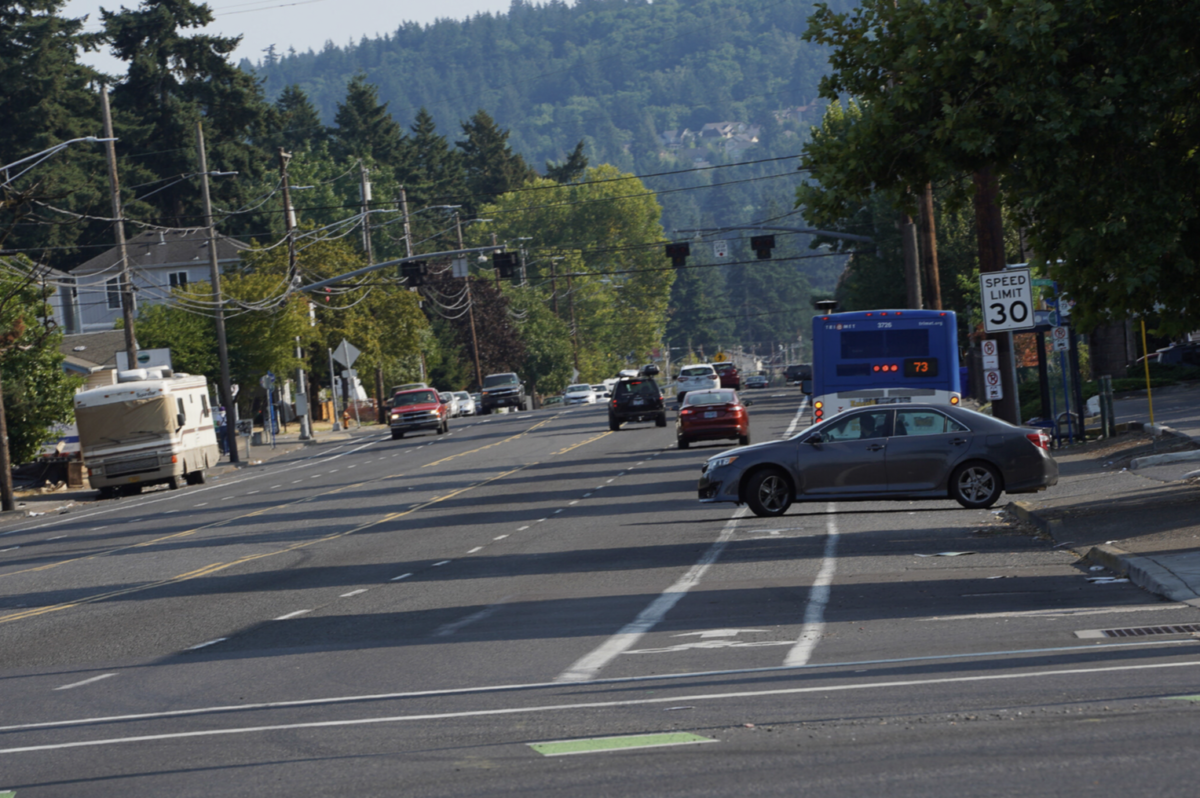


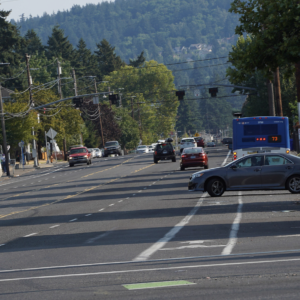
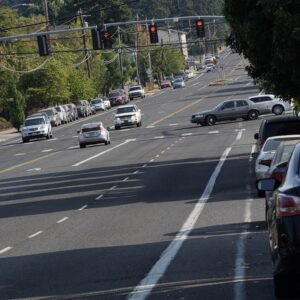
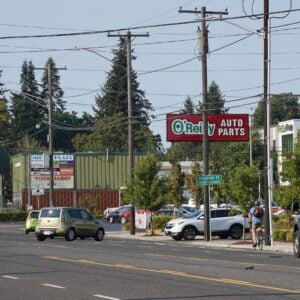
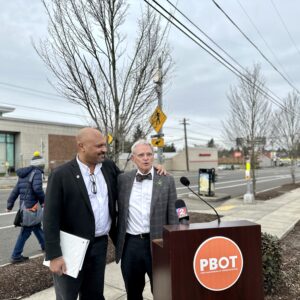
Thanks for reading.
BikePortland has served this community with independent community journalism since 2005. We rely on subscriptions from readers like you to survive. Your financial support is vital in keeping this valuable resource alive and well.
Please subscribe today to strengthen and expand our work.
I’m not convinced they can fit a safe roundabout there, unless that buy properties at 3 of the corners for more space. For safety bikes need to cross at least 2 car lengths from roundabout. Unfortunately the safe design is to make bikes give way. Roundabouts are more about motor vehicle flow and safety than bike and pedestrian convenience.
David Hembrow reviewed Dutch designs for roudabouts – the safe ones require a fair amount of space, and require bikes to yield:
http://www.aviewfromthecyclepath.com/2014/05/the-best-roundabout-design-for-cyclists.html
The best modern roundabout design for cyclists provides two choices. The more confident cyclist should merge with through traffic and circulate like a motorist. This is made easier by the low-speed operational environment of the modern roundabout, which should not exceed 20 mph (30 kph).
The less confident cyclist should be provided a ramp to exit the street and use a shared use path around the roundabout. Such paths should be at least ten feet wide (3 m) and cyclist should operate at low speeds, crossing at the pedestrian crossings. Sometimes space constraints, as with other intersection types, limit ideal design.
The NW to SE diagonal is 81 feet in the street. That is smaller than the standard minimum for an urban compact roundabout, 100 feet, similar to SW Terwilliger at Palater.
A mini-roundabout is all truck apron, so might work.
U-turn, Washtenaw County (mini):
https://www.youtube.com/watch?v=Ub7QYTFesFY&feature=youtu.be
St James, MN: Trucks at mini-roundabout:
https://www.youtube.com/watch?v=lP7J-f9gZ2E
https://www.youtube.com/watch?v=NbDX39eFRUI
https://www.youtube.com/watch?v=vxpN-ANiRbY
Using Google Maps, it looks like the proposed roundabout could fit within the current right-of-way even with the protected bike lanes (existing sidewalks don’t go all the way to the edge of the ROW). The diameter of the road circle would be about 75 feet, which USDOT classifies as a “mini-roundabout”, useful for average speeds up to 35 mph(!):
https://www.fhwa.dot.gov/publications/research/safety/00067/000671.pdf
Not sure about the requirement for two car lengths before the bicycle crossing. Many protected intersections in the Netherlands (including roundabouts) seem to have about a single car length of space before the crossing:
Junction design in the Netherlands [311] https://www.youtube.com/watch?v=XpQMgbDJPok&ab_channel=BicycleDutch
Why do we let engineers design our streets? They no nothing about ‘civic’ complete street active transportation infrastructure. This roundabout is pure auto-oriented bullsh*t. Out of direction travel for walkers and bikers and free flowing traffic is not a ‘safety’ improvement. This is a cut-and- paste replication of the NW 20th and Thurman sh*tshow. #Civicwashing.
Modern roundabouts operate at 20 mph or less. This is vastly safer than most crossing pedestrians or cyclist have to deal with.
No pedestrians have died crossing roundabout crosswalks since modern roundabouts were introduced to the US in 1990 (six have elsewhere). Only four cyclists have died at modern roundabout intersections in that same time, and there are about 8,000 modern roundabouts currently in the US.
The majority of traffic deaths do not involve pedestrians or cyclist, but people driving and all road users deserve safer roads.
Until people cross where it make sense instead of the marked crossing…
Still safer.
Going a little way “out of direction” has to be balanced against possibly going a mile out of one’s way to take an alternate route because this one is currently too dangerous. Reducing conflict points and the number of car lanes from two to one per direction is a definite safety improvement.
Reducing the number of lanes along 122nd between Foster and Holgate is great! The neighborhood lost its mind when Holgate went from 5 to 3 back in the early 2010s, but that reconfiguration has turned out really well overall. The buffered bike lanes don’t have protection, but it’s a lot better than it used to be.
I’m not in favor of a roundabout. Harold & 122nd isn’t really a problematic intersection currently. PBOT data shows 2 non-fatal injuries (1 bike, 1 red) between 2010 – 2019. That’s of course 2 more than there should be, but overall not an intersection that cries out urgently for a reconfiguration.
As Joesph notes, it’s more of a motor vehicle treatment than something that improves bike/ped safety. Given the level of driver inattentiveness, I’m definitely concerned for anyone tying to cross a roundabout at Harold or 122nd ‘going clockwise’ (drivers looking left as they approach and not paying attention to any bikes or peds coming from the right). The crossings in the diagram do appear to be set back far enough to avoid that conflict, but now you’ve just added another 100+ feet of out of direction travel for peds to cross the intersection.
The traffic signal helps to break up the traffic flow along 122nd and makes the crosswalks at Schiller and Raymond easier to use (as well as crossings at unmarked intersections). It’d help to have fewer travel lanes to cross, but I think breaks in traffic are they key for safe crossings of 122nd.
Reduce the lanes, leave the signal, and use the $ to put shoulders and sidewalks along Harold Street. That is really the only option for better bike and ped connectivity because it is the only east/west connecting street between Foster and Holgate (yes, there is the springwater, but it basically runs alongside Foster in this area, as well as having some other issues…). PBOT’s diagram shows nice improvements at the intersection, but I can guarantee that the project limits on any construction plans aren’t going to extend more than 200′ east or west from 122nd. After that, you’re on your own.
It’s not clear to me that Joseph actually designs roads for a living.
Joseph’s vocation (or avocations) hadn’t really crossed my mind when I was writing my comment. I guess I can’t say anything definitive about them other than that they’ve posted a response to a bikeportland article.
You’ve provided salient points on roundabout design in responses to the comments on this article. I’m curious about your take on the broader question – should a roundabout be installed at the intersection of 122nd and Harold?
Roundabouts do take additional land (expensive and impactful in an already developed area) and increase the crossing distance for peds (and bikes using the ped facilities). The intersection currently doesn’t appear to have safety or operational issues that would be significantly improved by a roundabout. Slower vehicle speed approaching, through, and departing the intersection would be a benefit, but the lane reduction and other traffic calming accomplish that too. It’s a solution looking for a problem, but that’s just my opinion.
It’s interesting that the two intersections highlighted in this article don’t even make the top 9 list on ‘Intersection Prioritization’ on page 34 of the draft plan.
They are probably being set up as “pilot projects” for bigger PBOT state and federal funding applications later on.
The roundabout image needs to be rotated 180 degrees to match the Google image.
I can’t help but notice that the “before” in the SE 122nd/Harold photos looks like the “after” in the 121st/Skidmore photos, and vice versa.
The 121st and Skidmore design is a great improvement for people walking and biking because it forces cars to stop while bikers and walkers cross, whereas currently vehicles appear to never have to stop.
The 122nd/Harold roundabout does the opposite–it takes an intersection where vehicles now have to stop for bikers and walkers to cross, and turns it into one where vehicles never have to stop.
Also, the roundabout at least doubles crossing distances, and turning cars will already be accelerating when they cross the crosswalks. It seems like the road diet without a roundabout would be much better.
It’s a common misperception that auto traffic at roundabouts never has to stop. Any left turn interrupts through movements of drivers and the slower speeds at a modern roundabout mean the delay to pause for a pedestrian is a minor inconvenience.
Confident cyclist can join drivers going around the circular island rather safely since it should operate at 20 mph or less. The design of the roundabout entries and exits keeps speeds low, not what you describe.
For a real life example, SW Terwilliger and Palater has a similar sized single-lane roundabout with lots of pedestrians when the college is in session. It was serving about 11,000 daily auto trips before the pandemic.
“It’s a common misperception that auto traffic at roundabouts never has to stop. Any left turn interrupts through movements of drivers and the slower speeds at a modern roundabout mean the delay to pause for a pedestrian is a minor inconvenience.”
I agree vehicles can need to stop prior to entering the roundabout, but once they’re in it they don’t. That means a person wanting to cross at any of the crosswalks always has the possibility that a vehicles will come at them from their left from the roundabout. At a standard signaled intersection, people using crosswalks are guaranteed that vehicles will be stopped when they cross.
In regard to vehicles entering the roundabout, yes, “the delay to pause for a pedestrian is a minor inconvenience” but we all know that that doesn’t mean drivers WILL stop. Again, at a standard signalized intersection, they MUST stop.
And people DO accelerate as they leave roundabouts, and if the roundabout is designed for operating at up to 20 mph, as you stated, that’s fast for going through a crosswalk.
“For a real life example, SW Terwilliger and Palater has a similar sized single-lane roundabout…”
I go through that one regularly, and it seems like it works well for that location (although other schemes might work better for pedestrians). But it also seems dissimilar in that one of the legs entering/leaving the roundabout is a fairly small private parking lot.
I’m not saying roundabouts are never a good option, just pointing out drawbacks, especially the ones for pedestrians which several others have also mentioned.
Roundabouts make people outside cars travel so far out of their way…
…whereas signalized intersections on 122nd are so safe for pedestrians that most will j-walk instead…
Let’s keep in mind we are discussing 122nd Avenue here, not inner Division, Mississippi, NW 23rd, or some other relatively narrow pedestrian-friendly street. 122nd is notoriously car-oriented. All pedestrian crossings along it are dangerous, including the pedestrian islands with flashing beacons, the non-ADA ped bridge north of San Rafael, and every single signalized intersection. What paikiala is trying to spell out is that given all the super dangerous intersections, traffic, and (suburban) land uses along 122nd, what is the safest type of crossings for pedestrians? There will never be traffic enforcement on 122nd on the scale needed, that’s a given. Signals currently don’t work on slowing traffic nor on making crossings safe for pedestrians. A roundabout at least slows car traffic down even when drivers ignore signals.
That doesn’t quite seem to jibe with the plan. Included among the extensive range of tools the plan proposes for slowing traffic and increasing safety are many more of the things–signals, pedestrian islands–which you say don’t currently prevent intersections from being dangerous, or slow traffic or make crossings safe.
Yet in all the several miles and dozens of intersection of 122nd, PBOT is proposing only one roundabout. You say that “What paikiala is trying to spell out is…what is the safest type of crossing for pedestrians?” Given that the plan stresses the importance of creating safe crossings (and assuming PBOT is genuinely trying to achieve that) PBOT’s answer to that is that several other strategies will work as well or better than roundabouts at every intersection along 122nd other than the one location at Harold.